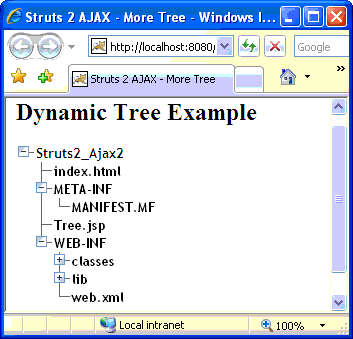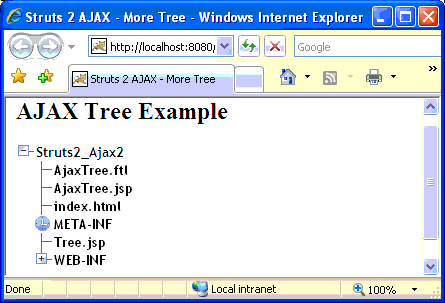在上一篇文章《Struts 2與AJAX(第一部分)》,我已經(jīng)簡(jiǎn)單地介紹了<s:tree
/>的一些用法,接下來(lái)我將繼續(xù)深入講解<s:tree />的使用和通過(guò)DWR實(shí)現(xiàn)AJAX校驗(yàn)。
更多<s:tree />
在Struts 2的showcase中有兩個(gè)<s:tree />的例子,分別是靜態(tài)樹(shù)與動(dòng)態(tài)樹(shù)。所謂的靜態(tài)樹(shù)即是在編寫(xiě)JSP代碼時(shí)通過(guò)<s:treenode
/>生成樹(shù)節(jié)點(diǎn)。我的上一篇文章的例子就是一個(gè)典型的靜態(tài)樹(shù)。而動(dòng)態(tài)樹(shù)則是在程序運(yùn)行期間,Struts 2 運(yùn)行時(shí)(Runtime)根據(jù)程序中的數(shù)據(jù)動(dòng)態(tài)創(chuàng)建樹(shù)節(jié)點(diǎn)。雖然在兩個(gè)例子中<s:tree
/>的theme屬性都為“ajax”,但是從嚴(yán)格意義上來(lái)說(shuō),這兩種樹(shù)都不屬于AJAX樹(shù),因?yàn)樗鼈兌际窃谳敵鲰?yè)面時(shí)將全部節(jié)點(diǎn)加載到其中,而不是在父節(jié)點(diǎn)展開(kāi)時(shí)通過(guò)XHR(XMLHttpRequest)獲取節(jié)點(diǎn)數(shù)據(jù)。
動(dòng)態(tài)樹(shù)
下面我們先看一下動(dòng)態(tài)樹(shù)的例子,接著再一步步地將其改造為名副其實(shí)的AJAX 樹(shù)。下例將會(huì)把WEB應(yīng)用程序的目錄樹(shù)展現(xiàn)在JSP頁(yè)面中。因此,我需要先包裝一下java.io.File
類(lèi),代碼如下:
 package tutorial;
package tutorial;

 import java.io.File;
import java.io.File;


 public
class FileWrapper
public
class FileWrapper
 {
{
 private
File file;
private
File file;


 public
FileWrapper(String path)
public
FileWrapper(String path)
 {
{
 file = new
File(path);
file = new
File(path);
 }
}


 public
FileWrapper(File file)
public
FileWrapper(File file)
 {
{
 this.file
= file;
this.file
= file;
 }
}


 public
String getId()
public
String getId()
 {
{
 return "file_"
+ file.hashCode();
return "file_"
+ file.hashCode();
 }
}


 public
String getName()
public
String getName()
 {
{
 return file.getName();
return file.getName();
 }
}


 public
String getAbsolutePath()
public
String getAbsolutePath()
 {
{
 return file.getAbsolutePath();
return file.getAbsolutePath();
 }
}


 public
FileWrapper[] getChildren()
public
FileWrapper[] getChildren()
 {
{
 File[] files = file.listFiles();
File[] files = file.listFiles();

 if(files
!=
null && files.length
> 0)
if(files
!=
null && files.length
> 0)
 {
{
 int length = files.length;
int length = files.length;
 FileWrapper[] wrappers
=
new FileWrapper[length];
FileWrapper[] wrappers
=
new FileWrapper[length];

 for(int
i =
0; i < length;
++i)
for(int
i =
0; i < length;
++i)
 {
{
 wrappers[i]
= new FileWrapper(files[i]);
wrappers[i]
= new FileWrapper(files[i]);
 }
}
 return wrappers;
return wrappers;
 }
}
 return new
FileWrapper[0];
return new
FileWrapper[0];
 }
}
 }
}
清單1 src/tutorial/FileWrapper.java
之所以需要對(duì)File類(lèi)進(jìn)行如此包裝,是因?yàn)?lt;s:tree />用于動(dòng)態(tài)樹(shù)時(shí),rootNode、nodeIdProperty、nodeTitleProperty
和 childCollectionProperty等屬性都必填的。
然后是Action類(lèi)的代碼如下:
 package tutorial;
package tutorial;

 import javax.servlet.http.HttpServletRequest;
import javax.servlet.http.HttpServletRequest;

 import org.apache.struts2.interceptor.ServletRequestAware;
import org.apache.struts2.interceptor.ServletRequestAware;

 import com.opensymphony.xwork2.ActionSupport;
import com.opensymphony.xwork2.ActionSupport;


 public
class DynamicTreeAction
extends ActionSupport
implements ServletRequestAware
public
class DynamicTreeAction
extends ActionSupport
implements ServletRequestAware
 {
{
 private
static
final long serialVersionUID
=
1128593047269036737L;
private
static
final long serialVersionUID
=
1128593047269036737L;

 private
HttpServletRequest request;
private
HttpServletRequest request;
 private
FileWrapper root;
private
FileWrapper root;


 public
void setServletRequest(HttpServletRequest
request)
public
void setServletRequest(HttpServletRequest
request)
 {
{
 this.request
= request;
this.request
= request;
 }
}


 public
FileWrapper getRoot()
public
FileWrapper getRoot()
 {
{
 return root;
return root;
 }
}

 @Override
@Override

 public
String execute()
public
String execute()
 {
{
 root = new
FileWrapper(request.getSession().getServletContext().getRealPath("/"));
root = new
FileWrapper(request.getSession().getServletContext().getRealPath("/"));
 return SUCCESS;
return SUCCESS;
 }
}
 }
}
清單2 src/tutorial/DynamicTreeAction.java
上述代碼取得WEB應(yīng)用程序的根目錄的絕對(duì)路徑后,初始化FileWrapper對(duì)象root。該對(duì)象將為JSP頁(yè)面的<s:tree />的根節(jié)點(diǎn)。如下代碼所示:
<%@ page language="java" contentType="text/html; charset=utf-8"
pageEncoding="utf-8"%>
<%@ taglib prefix="s"
uri="/struts-tags"%>
<!DOCTYPE html PUBLIC
"-//W3C//DTD XHTML 1.0 Transitional//EN" "http://www.w3.org/TR/xhtml1/DTD/xhtml1-transitional.dtd">
<html
xmlns="http://www.w3.org/1999/xhtml">
<head>
<title>Struts 2 AJAX - More Tree</title>
<s:head theme="ajax" debug="true"
/>
<script type="text/javascript">
/* <![CDATA[
*/
function treeNodeSelected(arg)
{
alert(arg.source.title
+ ' selected');
}
function treeNodeExpanded(arg)
{
alert(arg.source.title
+ ' expanded');
}
function treeNodeCollapsed(arg)
{
alert(arg.source.title
+ ' collapsed');
}
dojo.addOnLoad(function()
{
var
t = dojo.widget.byId('appFiles');
dojo.event.topic.subscribe(t.eventNames.expand,
treeNodeExpanded);
dojo.event.topic.subscribe(t.eventNames.collapse,
treeNodeCollapsed);
var s
= t.selector;
dojo.event.connect(s, 'select',
'treeNodeSelected');
});
/* ]]>
*/
</script>
</head>
<body>
<h2>
Dynamic Tree Example
</h2>
<div
style="float:left;
margin-right: 50px;">
<s:tree id="appFiles" theme="ajax" rootNode="root"
nodeTitleProperty="name" nodeIdProperty="id"
childCollectionProperty="children"
/>
</div>
</body>
</html>
清單3 WebContent/Tree.jsp
因?yàn)?lt;s:tree />的treeCollapsedTopic和treeExpandedTopic屬性都沒(méi)有起作用,所以如果我們想要監(jiān)聽(tīng)這兩個(gè)事件,就必須使用上述代碼的方法。
最后是struts.xml配置文件:
<?xml version="1.0"
encoding="UTF-8"?>
<!DOCTYPE
struts PUBLIC
"-//Apache Software Foundation//DTD Struts Configuration 2.0//EN"
"http://struts.apache.org/dtds/struts-2.0.dtd">
<struts>
<package
name="Struts2_AJAX_DEMO" extends="struts-default">
<action name="DynamicTree" class="tutorial.DynamicTreeAction">
<result>Tree.jsp</result>
</action>
</package>
</struts>
清單4 src/struts.xml
發(fā)布運(yùn)行應(yīng)用程序,在瀏覽器地址欄中鍵入http://localhost:8080/Struts2_Ajax2/DynamicTree.action,有如下圖所示頁(yè)面:

圖1 動(dòng)態(tài)樹(shù)示例
AJAX 樹(shù)
正如我在文章開(kāi)頭所說(shuō),Struts 2所提供的靜態(tài)樹(shù)和動(dòng)態(tài)樹(shù)都不是嚴(yán)格意義上的AJAX樹(shù)。下面就讓我們來(lái)實(shí)現(xiàn)一個(gè)如假包換的AJAX樹(shù)。首先要說(shuō)明的是,Struts
2的<s:tree />默認(rèn)是不支持這種按需加載數(shù)據(jù)的AJAX樹(shù)。不過(guò)因?yàn)樗腔贒ojo的樹(shù)控件(Widget)所以要擴(kuò)展也很方便。
Dojo 通過(guò)名為“TreeRPCController”的控件實(shí)現(xiàn) AJAX 樹(shù),它會(huì)監(jiān)聽(tīng)被控制樹(shù)的事件。當(dāng)發(fā)生展開(kāi)節(jié)點(diǎn)的事件時(shí),TreeRPCController就會(huì)向URL發(fā)送XHR請(qǐng)求,該URL由TreeRPCController的RPCUrl
屬性定義。XHR請(qǐng)求格式類(lèi)似如下格式:
http://localhost:8080/Struts2_Ajax2/AjaxTree.action?action=getChildren&data={"node":{"widgetId":"file_226092423","objectId":"C:\\Program
Files\\Tomcat 5.5\\webapps\\Struts2_Ajax2","index":0,"isFolder":true},"tree":{"widgetId":"appFiles","objectId":""}}&dojo.preventCache=1182913465392
清單5 XHR樣本
顯而易見(jiàn),請(qǐng)求中包含三個(gè)參數(shù),分別是action為“getChildren”(固定值),data一個(gè)包含當(dāng)前節(jié)點(diǎn)與樹(shù)信息的JSON串和dojo.preventCache隨機(jī)串,用于緩存不同節(jié)點(diǎn)的請(qǐng)求響應(yīng)(父節(jié)點(diǎn)只會(huì)在第一次被展開(kāi)時(shí)到服務(wù)器端加載數(shù)據(jù),之后都是從瀏覽器的緩存中讀取數(shù)據(jù),可以提高應(yīng)用程序性能)。
首先我要先寫(xiě)一個(gè)加載樹(shù)節(jié)點(diǎn)數(shù)據(jù)的Action類(lèi),代碼如下:
 package tutorial;
package tutorial;

 import java.util.Map;
import java.util.Map;

 import com.googlecode.jsonplugin.JSONExeption;
import com.googlecode.jsonplugin.JSONExeption;
 import com.googlecode.jsonplugin.JSONUtil;
import com.googlecode.jsonplugin.JSONUtil;


 public
class AjaxTreeAction
extends DynamicTreeAction
public
class AjaxTreeAction
extends DynamicTreeAction
 {
{
 private
static
final long serialVersionUID
=
3970019751740942311L;
private
static
final long serialVersionUID
=
3970019751740942311L;

 private
String action;
private
String action;
 private
String data;
private
String data;
 private
FileWrapper[] wrappers;
private
FileWrapper[] wrappers;


 public
void setAction(String
action)
public
void setAction(String
action)
 {
{
 this.action
= action;
this.action
= action;
 }
}


 public
void setData(String
data)
public
void setData(String
data)
 {
{
 this.data
= data;
this.data
= data;
 }
}


 public
FileWrapper[] getWrappers()
public
FileWrapper[] getWrappers()
 {
{
 return wrappers;
return wrappers;
 }
}

 @Override
@Override

 public
String execute()
public
String execute()
 {
{

 if("getChildren".equals(action))
if("getChildren".equals(action))
 {
{

 try
try
 {
{
 Object o
= JSONUtil.deserialize(data);
Object o
= JSONUtil.deserialize(data);
 String path
= ((Map) ((Map) o).get("node")).get("objectId").toString();
String path
= ((Map) ((Map) o).get("node")).get("objectId").toString();
 wrappers
=
new FileWrapper(path).getChildren();
wrappers
=
new FileWrapper(path).getChildren();

 }
catch (JSONExeption
e)
}
catch (JSONExeption
e)
 {
{
 e.printStackTrace();
e.printStackTrace();
 }
}
 return "ajax";
return "ajax";
 }
}
 return
super.execute();
return
super.execute();
 }
}
 }
}
清單6 src/tutorial/AjaxTreeAction.java
上述代碼可能需要解釋一下:
- action屬性對(duì)應(yīng)于XHR中的action,如果它為“getChildren”時(shí),則需要進(jìn)行加載子節(jié)點(diǎn)操作。否則,會(huì)讀取樹(shù)的根節(jié)點(diǎn),并返回JSP頁(yè)面;
- 通過(guò)上面XHR的分析,大家可以知道data是代表樹(shù)和當(dāng)前節(jié)點(diǎn)的JSON串,故應(yīng)將其反串行化為Map對(duì)象,并將其 objectId屬性取出。通常情況下,Dojo樹(shù)的objectId屬性代表服務(wù)器端的對(duì)象的標(biāo)識(shí),在本例中為文件夾的絕對(duì)路徑;
- wrappers屬性表示當(dāng)前文件夾下的文件數(shù)組,它被傳送到Freemarker頁(yè)面,翻譯為Dojo樹(shù)節(jié)點(diǎn)數(shù)組的JSON串。
下面是Freemarker頁(yè)面的代碼:
[
<#list
wrappers as r>
{ "title": "${r.name}", "isFolder":
<#if r.children?size
gt 0>true<#else>false</#if>, "id": "${r.id}", "objectId": "${r.absolutePath?js_string}"
}<#if
r_has_next>,</#if>
</#list>
]
清單7 WebContent/AjaxTree.ftl
以上代碼中<#list></#lsit>的寫(xiě)法是Freemarker中遍歷集合的寫(xiě)法;而<#if r.children?size
gt 0>判斷“r”對(duì)象的children屬性是否為空;r.absolutePath?js_string 就是將“r”的absolutePath屬性的值輸出為Javascript
的字串符形式;<#if r_has_next></#if>判斷集合是否有下一項(xiàng)數(shù)據(jù)。如果希望更詳細(xì)地了解Freemarker的使用,請(qǐng)參考該手冊(cè)。
接下來(lái),讓我們看看Action的配置代碼片段:
<action name="AjaxTree" class="tutorial.AjaxTreeAction">
<result>AjaxTree.jsp</result>
<result
name="ajax" type="freemarker">AjaxTree.ftl</result>
</action>
清單8 src/struts.xml配置片段
最后是JSP頁(yè)面代碼:
<%@ page language="java" contentType="text/html; charset=utf-8"
pageEncoding="utf-8"%>
<%@ taglib prefix="s"
uri="/struts-tags"%>
<!DOCTYPE html PUBLIC
"-//W3C//DTD XHTML 1.0 Transitional//EN" "http://www.w3.org/TR/xhtml1/DTD/xhtml1-transitional.dtd">
<html
xmlns="http://www.w3.org/1999/xhtml">
<head>
<title>Struts 2 AJAX - More Tree</title>
<s:head theme="ajax" debug="true"
/>
<script type="text/javascript">
/* <![CDATA[
*/
function treeNodeSelected(arg)
{
alert(arg.source.title
+ ' selected');
}
dojo.addOnLoad(function()
{
var
t = dojo.widget.byId('appFiles');
var s
= t.selector;
dojo.event.connect(s, 'select',
'treeNodeSelected');
});
/* ]]>
*/
</script>
</head>
<body>
<h2>
AJAX Tree Example
</h2>
<div
style="float:left;
margin-right: 50px;">
<script type="text/javascript">
/* <![CDATA[
*/
dojo.require("dojo.lang.*");
dojo.require("dojo.widget.*");
dojo.require("dojo.widget.Tree");
dojo.require("dojo.widget.TreeRPCController");
/*
]]> */
</script>
<div
dojoType="TreeRPCController" widgetId="treeController"
DNDcontroller="create" RPCUrl="<s:url />"></div>
<div dojoType="Tree" widgetId="appFiles" toggle="fade" controller="treeController">
<div
dojoType="TreeNode" title='<s:property
value="root.name" />'
widgetId='<s:property
value="root.id" />'
isFolder='<s:property
value="root.children.length
> 0" />'
objectId='<s:property
value="root.absolutePath" />'>
</div>
</div>
</div>
</body>
</html>
清單9 WebContent/AjaxTree.jsp
由于上面所提及的原因,我在上述的代碼中并沒(méi)有使用<s:tree />標(biāo)志,而是使用了Dojo的寫(xiě)法——?jiǎng)?chuàng)建 widgetId 為“treeController”的
TreeRPCController 并將設(shè)為樹(shù)的控制器。
發(fā)布運(yùn)行應(yīng)用程序,在瀏覽器地址欄中鍵入http://localhost:8080/Struts2_Ajax2/AjaxTree.action,點(diǎn)開(kāi)某個(gè)節(jié)點(diǎn),在節(jié)點(diǎn)加載的過(guò)程中,加號(hào)圖標(biāo)變成時(shí)鐘狀圖標(biāo),如下圖所示頁(yè)面:

圖2 AJAX樹(shù)示例
自定義<s:tree />的AJAX的主題(theme)
Struts 2的標(biāo)志過(guò)人之外在于它允許開(kāi)發(fā)人員自定義標(biāo)志的頁(yè)面輸出。要做到這一點(diǎn),你所需要做的只是創(chuàng)建一個(gè)自定義的theme并將其應(yīng)用到相應(yīng)標(biāo)志。下面就讓我自定義一個(gè)真正的AJAX的<s:tree/>的theme。
首先,你的源文件的根目錄下新建包“template.realajax”。
然后,在上一步所建的包中新建“tree.ftl”文件,內(nèi)容如下:
<script
type="text/javascript">
/* <![CDATA[
*/
dojo.require("dojo.lang.*");
dojo.require("dojo.widget.*");
dojo.require("dojo.widget.Tree");
dojo.require("dojo.widget.TreeRPCController"); <#--
Added by Max
-->
/* ]]>
*/
</script>
<#--
Added by Max -->
<div
dojoType="TreeRPCController"
widgetId="${parameters.id?html}_controller"
DNDcontroller="create"
RPCUrl="<@s.url />">
</div>
<#--
End -->
<div
dojoType="Tree"
<#if parameters.blankIconSrc?exists>
gridIconSrcT="<@s.url value='${parameters.blankIconSrc}'
encode="false"
includeParams='none'/>"
</#if>
<#if
parameters.gridIconSrcL?exists>
gridIconSrcL="<@s.url value='${parameters.gridIconSrcL}'
encode="false" includeParams='none'/>"
</#if>
<#if
parameters.gridIconSrcV?exists>
gridIconSrcV="<@s.url value='${parameters.gridIconSrcV}'
encode="false" includeParams='none'/>"
</#if>
<#if
parameters.gridIconSrcP?exists>
gridIconSrcP="<@s.url value='${parameters.gridIconSrcP}'
encode="false" includeParams='none'/>"
</#if>
<#if
parameters.gridIconSrcC?exists>
gridIconSrcC="<@s.url value='${parameters.gridIconSrcC}'
encode="false" includeParams='none'/>"
</#if>
<#if
parameters.gridIconSrcX?exists>
gridIconSrcX="<@s.url value='${parameters.gridIconSrcX}'
encode="false" includeParams='none'/>"
</#if>
<#if
parameters.gridIconSrcY?exists>
gridIconSrcY="<@s.url value='${parameters.gridIconSrcY}'
encode="false" includeParams='none'/>"
</#if>
<#if
parameters.gridIconSrcZ?exists>
gridIconSrcZ="<@s.url value='${parameters.gridIconSrcZ}'
encode="false" includeParams='none'/>"
</#if>
<#if
parameters.expandIconSrcPlus?exists>
expandIconSrcPlus="<@s.url value='${parameters.expandIconSrcPlus}'
includeParams='none'/>"
</#if>
<#if
parameters.expandIconSrcMinus?exists>
expandIconSrcMinus="<@s.url value='${parameters.expandIconSrcMinus?html}'
includeParams='none'/>"
</#if>
<#if
parameters.iconWidth?exists>
iconWidth="<@s.url value='${parameters.iconWidth?html}'
encode="false" includeParams='none'/>"
</#if>
<#if
parameters.iconHeight?exists>
iconHeight="<@s.url value='${parameters.iconHeight?html}'
encode="false" includeParams='none'/>"
</#if>
<#if
parameters.toggleDuration?exists>
toggleDuration=${parameters.toggleDuration?c}
</#if>
<#if
parameters.templateCssPath?exists>
templateCssPath="<@s.url value='${parameters.templateCssPath}'
encode="false" includeParams='none'/>"
</#if>
<#if
parameters.showGrid?exists>
showGrid="${parameters.showGrid?default(true)?string}"
</#if>
<#if
parameters.showRootGrid?exists>
showRootGrid="${parameters.showRootGrid?default(true)?string}"
</#if>
<#if
parameters.id?exists>
id="${parameters.id?html}"
</#if>
<#if
parameters.treeSelectedTopic?exists>
publishSelectionTopic="${parameters.treeSelectedTopic?html}"
</#if>
<#if
parameters.treeExpandedTopic?exists>
publishExpandedTopic="${parameters.treeExpandedTopic?html}"
</#if>
<#if
parameters.treeCollapsedTopic?exists>
publishCollapsedTopic="${parameters.treeCollapsedTopic?html}"
</#if>
<#if
parameters.toggle?exists>
toggle="${parameters.toggle?html}"
</#if>
controller="${parameters.id?html}_controller"
<#--
Added by Max -->
>
<#if
parameters.label?exists>
<div
dojoType="TreeNode" title="${parameters.label?html}"
<#if parameters.nodeIdProperty?exists>
id="${stack.findValue(parameters.nodeIdProperty)}"
<#else>
id="${parameters.id}_root"
</#if>
>
<#elseif
parameters.rootNode?exists>
${stack.push(parameters.rootNode)}
<#--
Edited by Max -->
<div
dojoType="TreeNode"
title="${stack.findValue(parameters.nodeTitleProperty)}"
widgetId="${stack.findValue(parameters.nodeIdProperty)}"
isFolder="<#if
stack.findValue(parameters.childCollectionProperty)?size gt 0>true<#else>false</#if>"
objectId="${stack.findValue(parameters.nameValue)}">
</div>
<#--
End -->
<#assign
oldNode = stack.pop()/>
<#--
pop the node off of the stack, but don't show it -->
</#if>
清單10 src/template/realajax/tree.ftl
對(duì)上述稍作解釋?zhuān)鲜龃a主要在原版的src/template/ajax/tree.ftl的基礎(chǔ)上添加了TreeRPCController的控件,并只輸出根節(jié)點(diǎn)。由于<s:tree
/>沒(méi)有類(lèi)似nodeObjectIdProperty的屬性,所以我用了value屬性表示objectId對(duì)應(yīng)的屬性名稱(chēng)。
接著新建tree-close.ftl文件,內(nèi)容和原版的一樣,如下所示:
<#if
parameters.label?exists></div></#if></div>
清單11 src/template/realajax/tree-close.ftl
再下來(lái)就應(yīng)該是將theme應(yīng)用到<s:tree />,如下代碼所示:
<%@ page language="java" contentType="text/html; charset=utf-8"
pageEncoding="utf-8"%>
<%@ taglib prefix="s"
uri="/struts-tags"%>
<!DOCTYPE html PUBLIC
"-//W3C//DTD XHTML 1.0 Transitional//EN" "http://www.w3.org/TR/xhtml1/DTD/xhtml1-transitional.dtd">
<html
xmlns="http://www.w3.org/1999/xhtml">
<head>
<title>Struts 2 AJAX - More Tree</title>
<s:head theme="ajax" debug="true"
/>
<script type="text/javascript">
/* <![CDATA[
*/
function treeNodeSelected(arg)
{
alert(arg.source.title
+ ' selected');
}
dojo.addOnLoad(function()
{
var
t = dojo.widget.byId('appFiles');
var s
= t.selector;
dojo.event.connect(s, 'select',
'treeNodeSelected');
});
/* ]]>
*/
</script>
</head>
<body>
<h2>
AJAX Tree Example
</h2>
<div
style="float:left;
margin-right: 50px;">
<s:tree id="appFiles" theme="realajax" rootNode="root"
nodeTitleProperty="name" nodeIdProperty="id"
childCollectionProperty="children" value="absolutePath"
/>
</div>
</body>
</html>
清單12 WebContent/AjaxTreeTheme.jsp
上述代碼中<s:tree />的用法,除了theme改為“realajax”和多了value="absolutePath"外,幾乎和靜態(tài)樹(shù)中的一樣。
為了不影響前一個(gè)例子,我們?yōu)樵揓SP文件配置類(lèi)型相同的Action,如下代碼所示:
<action name="AjaxTreeTheme" class="tutorial.AjaxTreeAction">
<result>AjaxTreeTheme.jsp</result>
<result
name="ajax" type="freemarker">AjaxTree.ftl</result>
</action>
清單13 src/struts.xml配置片段
發(fā)布運(yùn)行應(yīng)用程序,在瀏覽器地址欄中鍵入http://localhost:8080/Struts2_Ajax2/AjaxTreeTheme.action,結(jié)果如圖2所示。
總結(jié)
通過(guò)上述例子,大家知道Struts 2 的AJAX 標(biāo)志是基于Dojo控件開(kāi)發(fā)的,所以如果大家希望熟練地使用這些標(biāo)志,最好去了解一下Dojo。
本來(lái)還打算介紹一下Struts 2與DWR,不過(guò)看看文章的篇幅似乎足夠自成一篇了,因此DWR相關(guān)的內(nèi)容要留待下文繼續(xù)了。
posted on 2007-06-27 18:33
Max 閱讀(31374)
評(píng)論(41) 編輯 收藏 所屬分類(lèi):
Struts 2.0系列